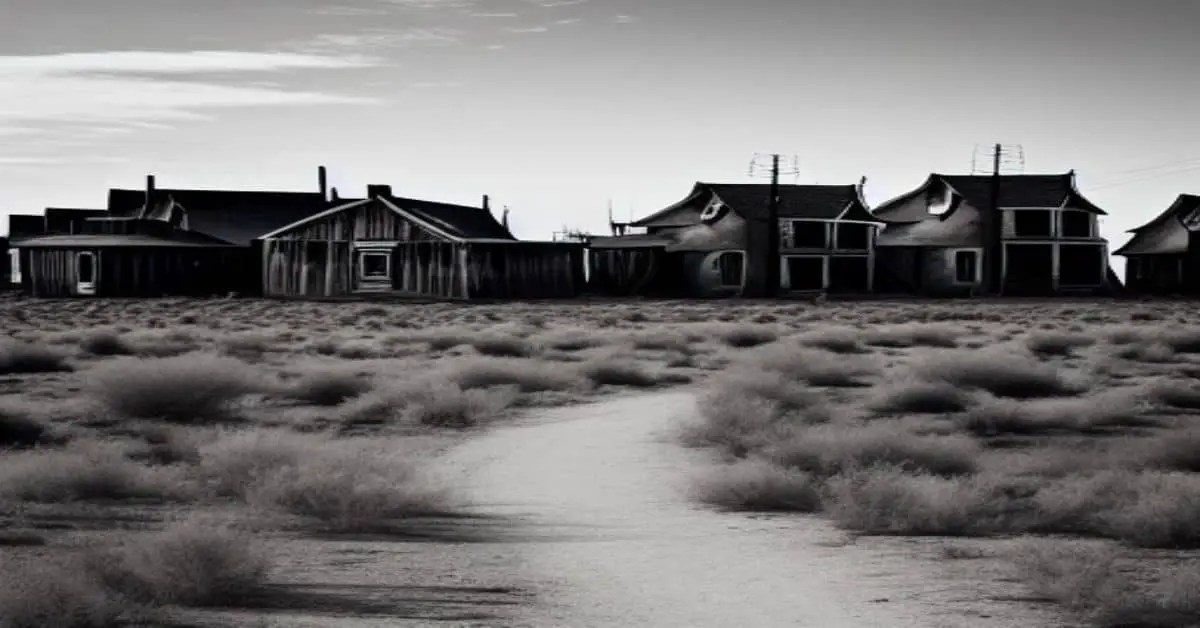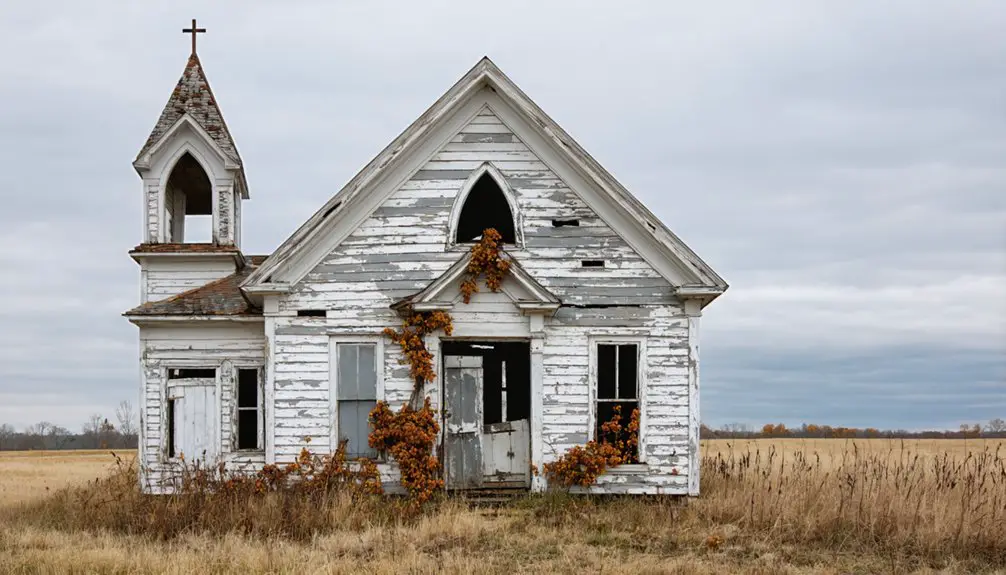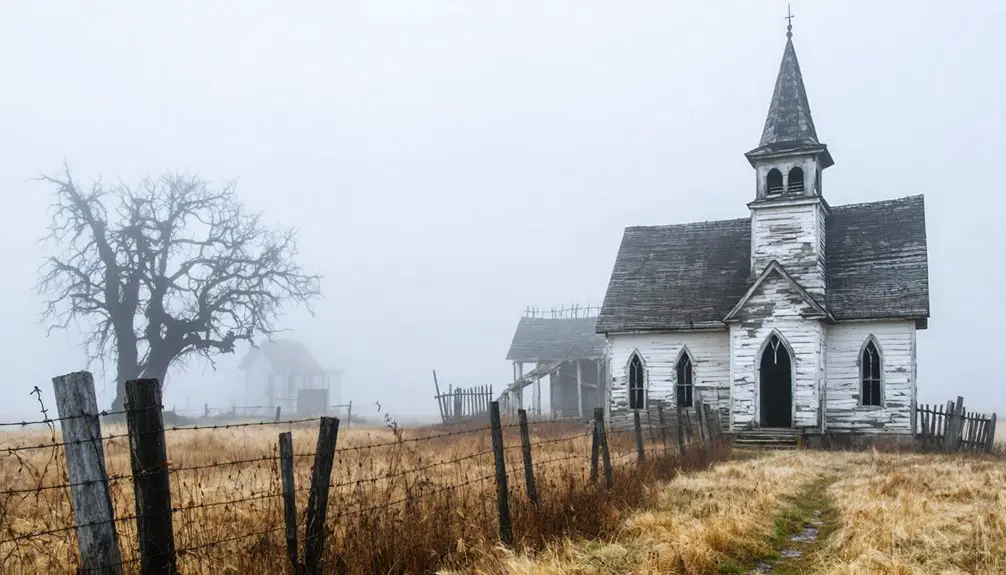You’ll find the ghostly ruins of Phenix, Missouri nestled in the Ozark landscape, where a once-thriving marble mining town flourished from 1884 to 1902. The site produced the prestigious “Napoleon Gray Marble,” featured in landmarks like the New York Stock Exchange and Missouri State Capitol. Today, you can explore crumbling foundations, rusted machinery, and weathered quarry cuts amid overgrown vegetation. The town’s sudden abandonment and overnight exodus holds intriguing secrets beneath its industrial remains.
Key Takeaways
- Phenix was a thriving marble quarry town established in 1884, known for producing high-quality Napoleon Gray Marble for prestigious buildings nationwide.
- The company town housed 250 workers and families, featuring company housing, a store, church, schools, and two hotels.
- Phenix marble was used in landmark buildings like the New York Stock Exchange and Missouri State Capitol.
- The town’s rapid decline began when quarry operations ceased, leading to a sudden exodus of residents.
- Today, visitors can explore industrial ruins, crumbling foundations, and abandoned quarry cuts in Missouri’s Ozark landscape.
The Rise of a Marble Mining Marvel
When railroad construction crews stumbled upon valuable marble and limestone deposits in 1884, they couldn’t have known they’d spark the creation of a thriving mining town.
Patrick Dugan seized the opportunity, launching a profitable lime kiln business that would soon shift its focus to marble extraction. By the 1890s, two major railroads served the area, setting the stage for unprecedented industrial growth.
A visionary entrepreneur’s lime operation evolved into a marble empire, as expanding rail networks fueled the region’s industrial boom.
The stone’s exceptional quality caught the eye of W. J. Grant, a Milwaukee marble finisher, who discovered it could be polished “like glass.” The marble went on to grace prestigious buildings like the Palace of Honor in San Francisco.
This remarkable characteristic, combined with its fine color and texture, earned it the name “Napoleon Gray Marble.” As operations expanded, the Phenix Marble Company emerged as one of Missouri’s largest stone producers, employing 250 workers and transforming the landscape. Workers earned 30 to 50 cents per hour, which was considered excellent compensation during that era.
Life in a Company Town’s Golden Era
Life in Phenix revolved around the marble company’s all-encompassing presence, with 250 workers and their families dwelling in company-provided housing during the early 20th century.
You’d find yourself living in a modest two- to four-room house, purchasing necessities at the company store with script money that couldn’t be spent elsewhere.
The community dynamics centered around shared spaces like the church, schoolhouse, and community hall, where worker relationships flourished despite the company’s tight control.
You’d notice distinct social layers between laborers and skilled artisans, reflected in housing arrangements and job roles.
The stone’s exceptional quality led to its use in prestigious projects like the New York Stock Exchange trading room walls.
While the company’s paternalistic approach limited independent choices, the town’s infrastructure – including two hotels and a railroad depot – supported a stable, if restricted, way of life for its residents.
The town’s economic stability lasted until Vermont Marble Co. purchased the quarry in 1945, marking the beginning of several ownership changes.
Architectural Legacy Across America
Beyond the daily rhythms of Phenix’s company town, the true magnitude of its influence stretched far across America through its prized marble.
You’ll find Phenix’s architectural legacy in landmarks from coast to coast, including the New York Stock Exchange and Los Angeles City Hall, where the marble’s distinctive artistry shines through polished surfaces and intricate details.
The stone’s remarkable durability and water resistance sparked architectural innovations that transformed America’s civic landscape.
Skilled stonemasons from Phenix perfected their craft, setting new standards for public buildings nationwide. The quarry’s high-quality limestone helped establish new benchmarks in construction materials during the late 1800s.
You can witness their expertise in the Missouri State Capitol‘s majestic Napoleon Gray facades and the elegant Palace of the Legion of Honor in San Francisco.
These enduring monuments showcase how a small Missouri town’s natural resources helped shape America’s architectural identity. The company town provided its workers with cultural amenities like an orchestra and library, fostering a thriving community of skilled craftsmen.
The Mysterious Overnight Exodus
Despite Phenix’s architectural legacy, the town met an abrupt end when its marble and limestone quarry operations ceased.
Phenix’s grand buildings and elegant facades couldn’t save the town once its lifeblood – the marble quarries – ran dry.
You’ll find that the town’s economic vulnerability, stemming from its dependence on a single industry, led to its dramatic downfall. When quarry resources depleted, the company’s sudden shutdown triggered an unprecedented community dissolution.
The exodus happened almost overnight, as most residents were quarry employees with company-controlled housing. You can imagine how quickly the social fabric unraveled – the library, orchestra, and church all ceased operations as families departed en masse. The company store closed in 1902, marking the beginning of the town’s decline.
Without alternative employment options or functioning amenities, residents had no choice but to relocate simultaneously. The industrial landscape, scarred by years of quarrying, stood as a stark reminder of the town’s singular purpose and ultimate demise. Much of the town’s mining equipment was scrapped for World War II, accelerating the community’s decline.
Exploring the Ruins Today
Today’s visitors to Phenix will find a haunting tableau of industrial ruins nestled in Missouri’s Ozark landscape.
The town’s thriving mining past is evident in the scattered remnants that dot the landscape today.
You’ll discover crumbling foundations, rusted machinery, and weathered quarry cuts that tell the story of this abandoned industrial town.
Located between Ash Grove and Walnut Grove, the site offers unique ruins exploration and photography opportunities among the overgrown vegetation and historic remnants.
Recent archaeological studies have uncovered important artifacts that provide insights into daily life in this historic company town.
- Navigate carefully through uneven terrain to discover remnants of worker paths and industrial infrastructure
- Capture dramatic shots of the quarry canyon against the backdrop of Ozark forests
- Watch for local wildlife while exploring the partially obscured ruins
- Visit during different seasons to experience varying atmospheric conditions
- Bring research materials, as limited signage exists to guide your exploration
Frequently Asked Questions
What Happened to the Original Quarry Equipment After the Town’s Abandonment?
You’ll find the quarry equipment’s historical significance ended during the Great Depression, when it was dismantled and melted down to create weapons for World War II’s military production needs.
Were There Any Documented Accidents or Deaths in the Phenix Quarries?
You won’t find any officially documented deaths or accidents in historical records, though quarry safety was a major concern. Local legends might tell different stories, but they’re not historically verified.
Did Native Americans Use the Marble Deposits Before the Town’s Establishment?
You won’t find evidence of Native uses at this marble site. While they mined other Missouri materials like flint and lead, there’s no indication they worked these specific marble deposits.
What Was the Average Salary of Quarry Workers in Phenix?
You’d find quarry wages ranged from 30-50 cents per hour, earning workers about $18-30 weekly for grueling labor conditions spanning 10-hour days, six days a week in all weather.
Are There Any Surviving Descendants of Original Phenix Residents Still Living Nearby?
You’ll find some descendants still live within 10-20 miles, based on family connections and local stories, though there’s no formal tracking system to confirm exact numbers or locations.
References
- https://www.youtube.com/watch?v=i_P1RG3Inv8
- https://www.undergroundozarks.com/phenix.html
- http://www.slipperyrockgazette.net/index.cfm/pageId/2661
- https://sgcld.thelibrary.org/lochist/frisco/allaboard/Optimized/1992_6-7_v7_1_08.pdf
- https://www.youtube.com/watch?v=OPNh93z9dNE
- https://www.undergroundozarks.com/phenixs.html
- http://www.slipperyrockgazette.net/index.cfm/pageId/2652
- https://gsa.confex.com/gsa/2010NC/webprogram/Paper168369.html
- https://www.stoneworld.com/articles/89515-phenix-marble-co-the-resurrection-of-a-historic-stone
- https://quarriesandbeyond.org/states/mo/mo-quarry_photos_18.html



